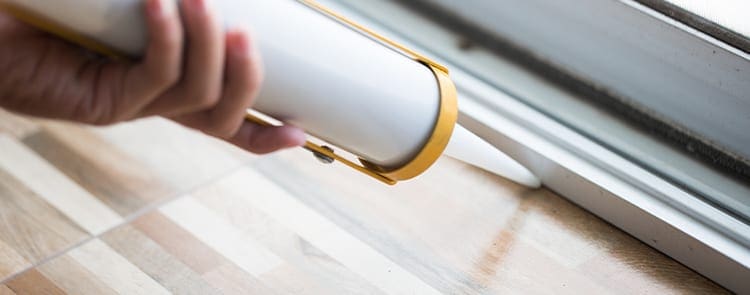Blogs
Air Sealing Tips to Prep Your Home for the Winter
9/11/2015

Winter is fast approaching, and it’s never a bad idea to prepare for weather before it shows. With that in mind, let’s take a look at how you can improve home insulation to keep heat (or even cold during the summer) inside your home.
Places to Check
The first thing to do is inspect the more common places where leaks occur. A visual inspection for any cracks or gaps will reveal the most obvious faults and flaws. Examine any existing insulation, sealant, or weather strips for degradation and wear. You can also use a smoke stick to identify moving air within a room, which will more easily highlight leaks.
- Attic – Inspect around downlights, ceiling fixtures, and vent pipes. Damage or cracks around ceiling joins or in the corners where walls connect can also affect insulation. You should also make sure that you have roughly 12 inches of insulation lining the floor of your attic to prevent heat transfer between your home and the attic. This will keep your house cool in the summer and prevent ice dams from forming in the winter.
- Basement – As with the attic, inspecting where walls meet the floor is ideal. You should also inspect any grates or vents leading into or out of the basement for extra leaks. Crawlspaces, appliance outlets, or sump pump lines can also develop cracks or leaks to the outside.
- Windows and Doors – Replace any damaged weather-stripping around doors and add weatherproof strips to current gaps. Seal around windows and switch to double-paned glass.
- Garage – We often forget to check the garage for insulation issues but you shouldn’t. Everything you would inspect inside your home (doors, windows, vents) should be checked here as well. Make sure entrances into the attic are properly sealed as well.
- Utility Entry Points (chimney, vents, cables) – Whether it’s the heat vent for a dryer or the chimney in your living room, most rooms have some space that’s connected to the outside. Inspect any above-ground cable or pipe entry points for lost insulation.
Weatherproofing
Once you’ve identified where the issues are, it’s time to correct them. Depending on the type of leak, you have a few options for resolving it. Silicone caulking, weatherstrips, and expanding foam are all fairly inexpensive methods of insulation.
- Caulk – A quick fix for small gaps or cracks. Only use this on stationary objects with very little flexing room. Don’t’ try to cover gaps that exceed ¼ of an inch.
- Weatherstrips – Perfect for non-stationary objects. Weatherstrips are often used to seal off doors and windows when they aren’t capable of forming a full seal by themselves.
- Expanding Foam – Wider gaps require expanding foam. When a simple caulking won’t work, foam fills the gap. Just be cautious of how you apply the foam. In the wrong place, it can become an eyesore if it becomes too visible.
Professional Services
The last step (or the first one depending on how much time you have) is to call a professional for an inspection. Professional technicians have tools, resources, and training that’s not common for the every-day homeowner. Our techs at Service Legends, for instance, know exactly what to look for. We can even inspect the ductwork within your home for additional air leaks, then fix them before we leave.
Heating and Cooling Des Moines Since 1997
At Service Legends, we take pride in heating and cooling Des Moines and the surrounding areas. Our HVAC services include furnace and air conditioner installation, repairs, maintenance, and tune-ups. Our lineup of Indoor Air Quality solutions includes whole-home humidifiers, air purifiers, and air filtration systems. We can even help with HVAC financing.
Call 515-657-6634 to contact our Home Comfort Heroes today. We’re standing by 24/7.
Return- July 2025
- June 2025
- May 2025
- February 2025
- January 2025
- December 2024
- October 2024
- June 2024
- October 2023
- September 2023
- August 2023
- January 2023
- December 2022
- November 2022
- October 2022
- September 2022
- August 2022
- July 2022
- June 2022
- May 2022
- April 2022
- March 2022
- February 2022
- January 2022
- May 2021
- November 2020
- October 2020
- September 2020
- July 2020
- June 2020
- May 2020
- March 2020
- February 2020
- December 2019
- November 2019
- September 2019
- May 2019
- April 2019
- January 2019
- December 2018
- November 2018
- October 2018
- July 2018
- October 2016
- September 2016
- August 2016
- July 2016
- June 2016
- May 2016
- April 2016
- March 2016
- February 2016
- January 2016
- December 2015
- November 2015
- October 2015
- September 2015
- August 2015
- July 2015
- June 2015
- May 2015
- April 2015
- March 2015
- February 2015
- January 2015
- December 2014
- November 2014
- October 2014
- September 2014
- August 2014
- July 2014
- May 2014
- March 2014
- February 2014
- January 2014
- December 2013
- November 2013
- October 2013
- September 2013